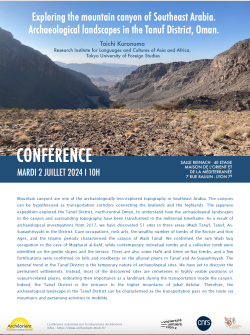
- Mardi 2 juillet 2024, 10h, Salle Reinach, 4e étage, MOM, Lyon
Conférence de Taichi Kuronuma (Research Institute for Languages and Cultures of Asia and Africa and Tokyo University of Foreign Studies Field Science Commons (TUFiSCo), invité par le laboratoire Archéorient.
La conférence s’intitule :"Exploring the mountain canyon of Southeast Arabia. Archaeological landscapes in the Tanuf District, Oman."
Affiche (.pdf)
Suivre la présentation à distance sur Zoom
ID de réunion: 954 7340 5567
Code secret: Q8u7b8
Mountain canyons are one of the archaeologically less-explored topography in Southeast Arabia. The canyons can be hypothesised as transportation corridors connecting the lowlands and the highlands. The Japanese expedition explored the Tanuf District, north-central Oman, to understand how the archaeological landscapes in the canyon and surrounding topography have been transformed in the millennial timeframe. As a result of archaeological investigations from 2017, we have discovered 51 sites in three areas (Wadi Tanuf, Tanuf, As-Suwayhriyyah) in the District. Cave occupations, rock arts, the wealthy number of tombs of the Bronze and Iron Ages, and the Islamic periods characterised the canyon of Wadi Tanuf. We confirmed the rare Wadi Suq occupation in the cave of Mugharat al-Kahf, while contemporary individual tombs and a collective tomb were identified on the gentle slopes and the terrace. There are also some Hafit and Umm an-Nar tombs, and a few fortifications were confirmed on hills and inselbergs on the alluvial plains in Tanuf and As-Suwayhriyyah. The general trend in the Tanuf District is the temporary nature of archaeological sites. We have yet to discover the permanent settlements. Instead, most of the discovered sites are cemeteries in highly visible positions or sojourn-related places, indicating their importance as a landmark during the transportation inside the canyon. Indeed, the Tanuf District is the entrance to the higher mountains of Jabal Akhdar. Therefore, the archaeological landscape in the Tanuf District can be characterised as the transportation pass on the route via mountains and pertaining activities to mobility.